How to Pick the Right Ergonomic Mouse for Comfort and Productivity
If you spend hours each day using a computer, you might not realize how much impact your mouse has on your overall health, comfort, and productivity. A poorly designed mouse can lead to repetitive strain injuries (RSIs), carpal tunnel syndrome, tendonitis, and even long-term nerve damage. Over time, even subtle discomfort can snowball into chronic issues that not only hurt your physical well-being but also disrupt your ability to work or enjoy leisure activities.
The wrong mouse can cause:
Wrist pain and stiffness: Constant unnatural wrist positioning strains tendons and ligaments.
Forearm and shoulder fatigue: Extended use forces muscles to compensate for poor ergonomics.
Finger cramps and numbness: Tight grips and repetitive clicking can overwork your fingers.
Reduced productivity: Physical discomfort leads to frequent breaks, reduced focus, and slower performance.
On the flip side, the right ergonomic mouse can dramatically improve your experience:
Key benefits of a good ergonomic mouse:
Natural hand posture: Supports the hand in a relaxed, neutral position to minimize strain.
Enhanced precision and control: A comfortable mouse makes it easier to execute fine movements, improving efficiency in tasks like graphic design, spreadsheets, coding, and gaming.
Increased endurance: Less muscle fatigue means you can work longer with greater focus.
Injury prevention: Reduces the risk of developing RSIs or worsening existing conditions.
Why Ergonomics Matter More Than Ever
With the rise of remote work, gaming, and digital lifestyles, many people are using their computers more than ever before—often without the benefit of professionally designed office setups. Ergonomics is no longer a concern only for people with existing conditions; it’s now a proactive approach to maintaining health and optimizing performance.
Choosing the right ergonomic mouse is a small change that leads to big results. Whether you’re a graphic designer who needs pixel-perfect control, a gamer needing lightning-fast clicks, or a remote worker handling emails and spreadsheets all day, the mouse you choose should support—not sabotage—your body’s natural mechanics.
Signs You Need to Upgrade Your Mouse
Not sure if your current mouse is harming you? Watch for these warning signs:
Tingling or numbness in your fingers after using your mouse
Aching wrists or hands during or after computer sessions
Tightness or pain radiating up your forearm
Frequent need to stretch or shake out your hand while working
Noticeable difference in comfort when switching hands
If you experience any of these symptoms, upgrading to an ergonomic mouse could provide immediate relief and prevent further injury.
Common Ergonomic Mouse Shapes: Vertical, Trackball, Split
Not all ergonomic mice are created equal. Different shapes cater to different needs, hand sizes, and even specific injuries. Understanding the main ergonomic mouse types can help you choose the one that best aligns with your body mechanics and daily tasks.
Here’s a deep dive into the most popular ergonomic mouse designs and why each might be the perfect fit for you:
Vertical Mice
A vertical mouse is designed to keep your hand in a handshake position rather than a traditional palm-down grip. This adjustment dramatically reduces the pronation of the wrist (turning the palm downward), which is a major contributor to repetitive strain injuries.
Key benefits of vertical mice:
Natural forearm alignment: Mimics the neutral position your arm naturally rests in when relaxed.
Reduced muscle tension: Less twisting means lower strain on the forearm, wrist, and hand muscles.
Better blood flow: Reduces compression of veins and nerves in the wrist, helping circulation.
Ideal for:
People with early signs of carpal tunnel syndrome
Users who experience wrist or elbow pain
Anyone seeking to prevent future repetitive stress injuries
Example models:
Logitech MX Vertical — a premium option combining ergonomics with customizable buttons.
Anker Ergonomic Vertical Mouse — a popular budget-friendly alternative.
It may take a few days or even a couple of weeks to fully adjust to using a vertical mouse, as the movement is quite different from a traditional setup.
Trackball Mice
Trackball mice flip the concept of movement on its head: instead of moving the entire device across your desk, you control the cursor by rotating a stationary ball embedded in the mouse.
Key benefits of trackball mice:
Minimal arm movement: Perfect for reducing shoulder and upper-arm fatigue.
Space-saving design: Ideal for small desks, crowded workspaces, or couch setups.
Precision control: Some users find trackballs allow for very fine cursor movements without the need to reposition the mouse.
Ideal for:
Users with limited desk space
People experiencing shoulder or arm pain
Creative professionals who require fine control (after the learning curve)
Example models:
Kensington Expert Mouse Wireless Trackball — a large ball and four customizable buttons for professional work.
Logitech Ergo M575 — an affordable and extremely comfortable thumb-operated trackball.
Trackballs have a steeper learning curve, and maintenance (occasional ball cleaning) is required to keep them working smoothly.
Split or Ergonomically Contoured Mice
Split ergonomic mice or sculpted mice are designed to fit the natural curves of your hand more precisely than traditional flat mice. Some split designs physically separate sections for different fingers, while contoured mice simply offer an optimized ergonomic shape without full separation.
Key benefits of split or contoured mice:
Customized fit: Supports natural finger placement, reducing strain on each individual finger.
Natural wrist angle: Often slightly tilted to prevent overextension or awkward bending.
Less grip force required: The mouse contours support your hand’s weight, leading to a lighter, more relaxed grip.
Ideal for:
Office professionals who spend 6–8+ hours at a desk
People with finger joint discomfort or arthritis
Users who prefer a traditional mouse movement style but want better ergonomics
Example models:
Microsoft Sculpt Ergonomic Mouse — designed for all-day comfort with a thumb scoop.
Contour Unimouse — adjustable in angle and size for a truly custom ergonomic experience.
Potential drawbacks:
Split mice can feel bulky at first if you are used to slim, compact mice. Some models may also be priced higher due to advanced design features.
Which Ergonomic Shape is Right for You?
Choosing between these shapes comes down to a few key factors:
Current pain points: Wrist, forearm, shoulder, or fingers
Desk space: Limited space may favor a trackball
Preferred grip style: Relaxed palm grip vs. thumb control
Adaptation time: How quickly you’re willing to adjust to a new movement style
Work tasks: Precision work like photo editing may benefit from trackballs, while general office work suits vertical or contoured designs
Taking a little time to match the right ergonomic mouse to your specific needs can save you a lot of discomfort—and even prevent future injury.
Wired vs. Wireless: What’s Best for Ergonomics?
When it comes to choosing an ergonomic mouse, the shape and design are crucial—but the connection type (wired vs. wireless) also plays a bigger role than you might expect. While ergonomics is primarily about the mouse’s physical form, the way your mouse connects to your device can impact your posture, workspace setup, and overall comfort.
Wired Mice: Pros and Cons for Ergonomics
Advantages of Wired Ergonomic Mice:
Consistent Connection: Wired mice have a direct link to your computer, providing a stable, lag-free experience. This is especially important for tasks requiring precision, like graphic design or gaming.
No Battery Worries: You never need to pause to charge or swap batteries, ensuring uninterrupted workflow.
Lower Cost: Wired versions are typically more affordable than their wireless counterparts, meaning you can invest in a higher-quality ergonomic design without breaking the bank.
Ergonomic Challenges with Wired Mice:
Cable Drag: The resistance from the cable can interfere with smooth mouse movement, causing subtle tension in your wrist or arm over time.
Limited Range: Your movement is restricted by the length and flexibility of the cable, which could encourage awkward wrist angles or desk clutter if not managed properly.
Desk Organization: Managing a cable means an extra step in maintaining a clean, ergonomic workspace, and messy cables can interfere with ideal hand positioning.
Use a mouse bungee (a device that holds the cable up and out of the way) to minimize drag and improve your desk ergonomics.
Wireless Mice: Pros and Cons for Ergonomics
Advantages of Wireless Ergonomic Mice:
Greater Freedom of Movement: Without a cord tethering you, your wrist, forearm, and shoulder can move more naturally, reducing strain and allowing for better posture.
Cleaner, Minimalist Desk Setup: A tidier desk promotes better ergonomics overall, as it reduces clutter that might otherwise cause awkward hand positioning.
Portability: Wireless mice are ideal for people who work in multiple locations, travel often, or switch between devices. Ergonomic comfort on the go becomes much easier.
Ergonomic Challenges with Wireless Mice:
Battery Management: Some wireless mice require frequent recharging or battery changes. Constant dead batteries can interrupt your workflow and cause tension if you need to awkwardly use a charging cable while operating the mouse.
Potential for Slight Input Lag: Although modern wireless technology (especially Bluetooth Low Energy and proprietary wireless dongles like Logitech’s Unifying Receiver) has minimized this, some users sensitive to latency might still notice minor differences.
Choose a wireless ergonomic mouse with long battery life or a quick-charging feature. Models like the Logitech MX Master 3S can last up to 70 days on a full charge and allow for hours of use after just a few minutes of charging.
Health and Ergonomics Perspective: Which is Better?
For long, stationary work sessions (such as a home office setup), a wired ergonomic mouse is perfectly fine as long as cable management is handled properly.
For dynamic, flexible setups (or if you prefer a minimalist workspace), a wireless ergonomic mouse typically provides a better overall ergonomic experience because of the freedom of movement it allows.
In essence, wireless mice offer a small but real ergonomic advantage by promoting a cleaner setup and more natural range of motion. However, if you already have a well-organized, cable-managed desk, a wired mouse won’t significantly hurt your ergonomics—and it may save you the hassle of battery maintenance.
Hybrid Options: Best of Both Worlds
Some premium ergonomic mice now offer both wired and wireless functionality, giving users the flexibility to switch depending on their needs.
For example:
Use wireless mode for normal daily work to maximize freedom.
Plug in a USB cable during heavy gaming or precision tasks to ensure zero-latency performance.
Example Hybrid Models:
Logitech MX Master 3S
Razer Basilisk Ultimate
SteelSeries Rival 650 Wireless
Choosing a hybrid model means you won’t have to compromise between ergonomic comfort and performance reliability.
Both wired and wireless ergonomic mice have their merits. The best choice for you comes down to how and where you work, your sensitivity to lag, and your desire for a clean, flexible workspace. For maximum ergonomic benefit, prioritize wireless freedom if possible—but never at the cost of a poorly designed mouse shape.
Best Ergonomic Mice for Office Work, Gaming, and Travel
Choosing the best ergonomic mouse is about matching the right tool to your specific needs—whether you’re spending eight hours at a desk, conquering levels in intense gaming sessions, or hopping between coworking spaces. Here’s a curated list of the top ergonomic mice across various uses, complete with detailed reviews to help you pick the perfect one.
Logitech MX Master 3S — Best for Office Work
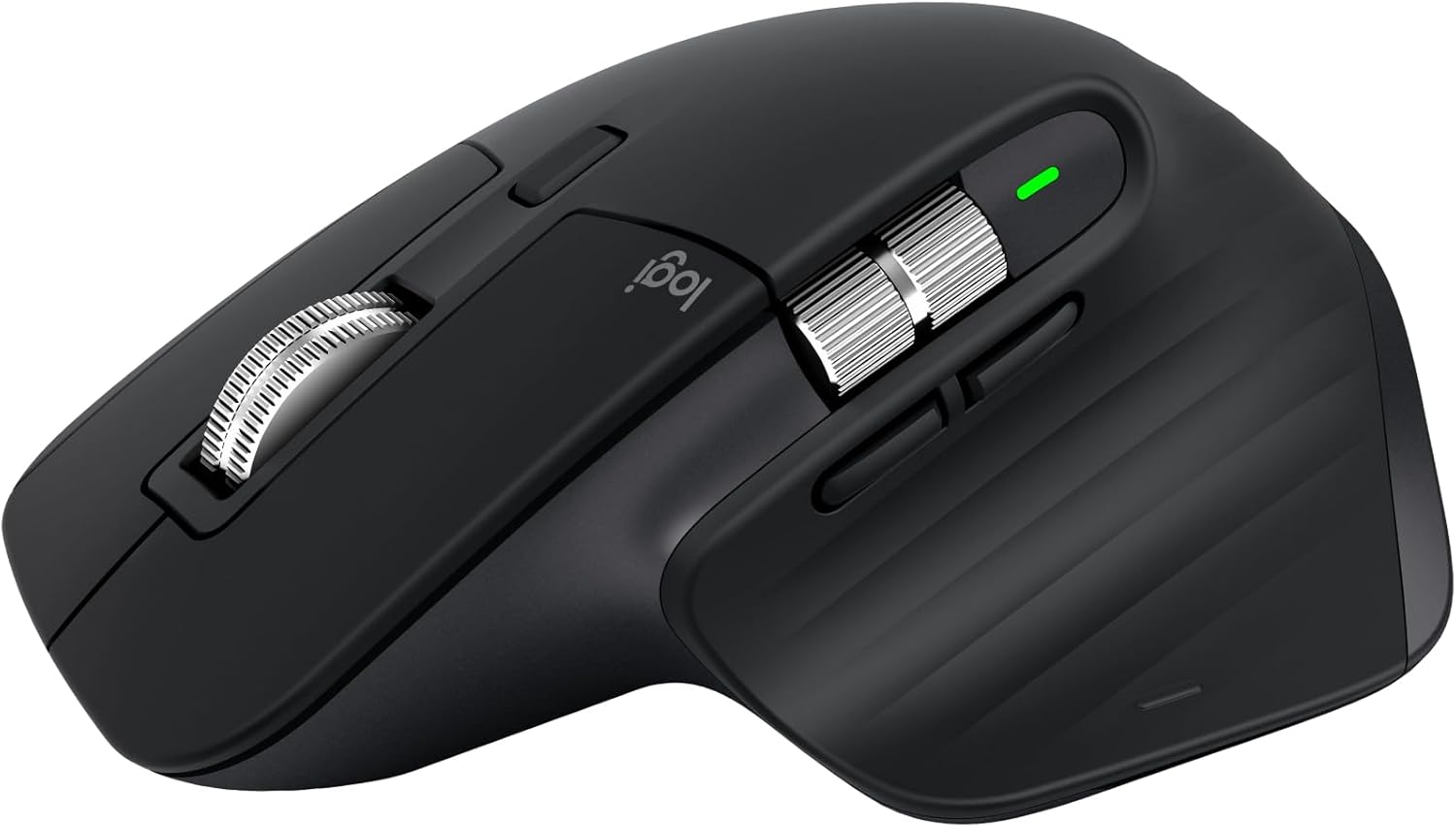
The Logitech MX Master 3S stands at the pinnacle of productivity-focused ergonomic mice. Designed with professional users in mind, it features a contoured shape that perfectly fits the hand, promoting a natural palm rest and reducing wrist fatigue.
Key Features:
8,000 DPI high-precision sensor
MagSpeed Electromagnetic scroll wheel (ultra-fast scrolling)
Ability to connect to up to 3 devices simultaneously via Bluetooth or Unifying Receiver
Quiet clicks for distraction-free work
USB-C rechargeable with 70-day battery life
The sculpted design encourages a relaxed grip that’s perfect for long hours at a desk. Plus, the customizable buttons and super-smooth scroll wheel make multitasking across documents, spreadsheets, and design files effortless.
Potential Downsides:
Premium pricing
Might be a bit large for users with very small hands
Verdict:
If you’re looking for the ultimate ergonomic mouse for productivity, the Logitech MX Master 3S is an unbeatable investment.
Razer Basilisk V3 — Best for Gaming
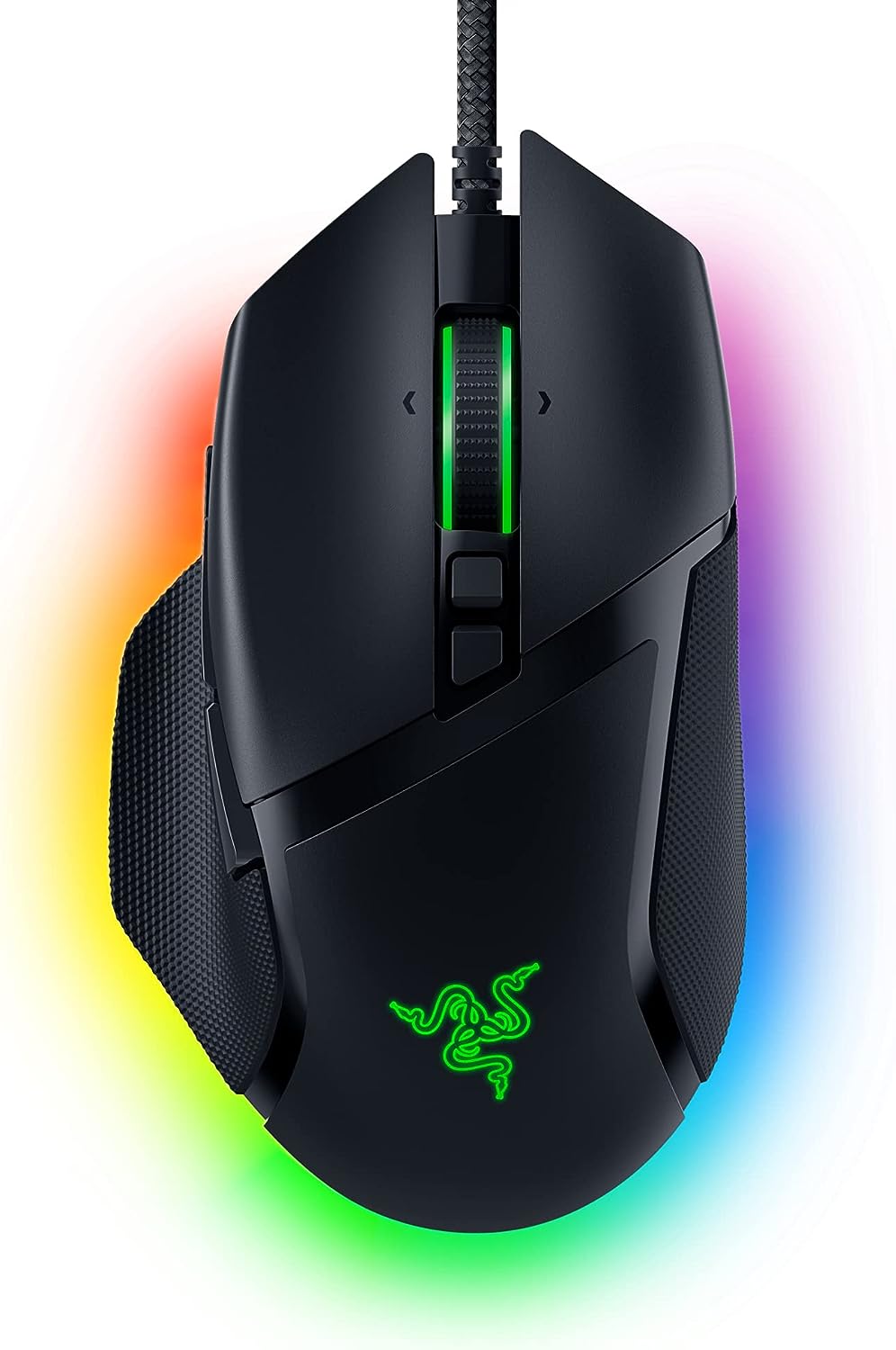
Gaming demands a different kind of ergonomic excellence: speed, precision, and endurance. The Razer Basilisk V3 delivers it all, with an ergonomic form designed for right-handed users who need fast access to programmable controls and flawless performance.
Key Features:
26,000 DPI optical sensor
11 programmable buttons
Adjustable scroll wheel resistance
Ergonomic thumb rest for improved comfort
Razer Chroma RGB lighting for customization
Why It’s Great for Gaming: The Basilisk V3’s customizable buttons and precision-tuned ergonomic shape make it ideal for marathon gaming sessions. The thumb rest and carefully contoured shape reduce fatigue during long plays, while the high DPI and customizable profiles ensure you stay competitive.
Wired only (no wireless version for this model)
May be too bulky for fingertip grip players
Verdict:
For ergonomic gaming performance without compromise, the Basilisk V3 hits the perfect balance of comfort, speed, and control.
Logitech MX Anywhere 3 — Best for Travel
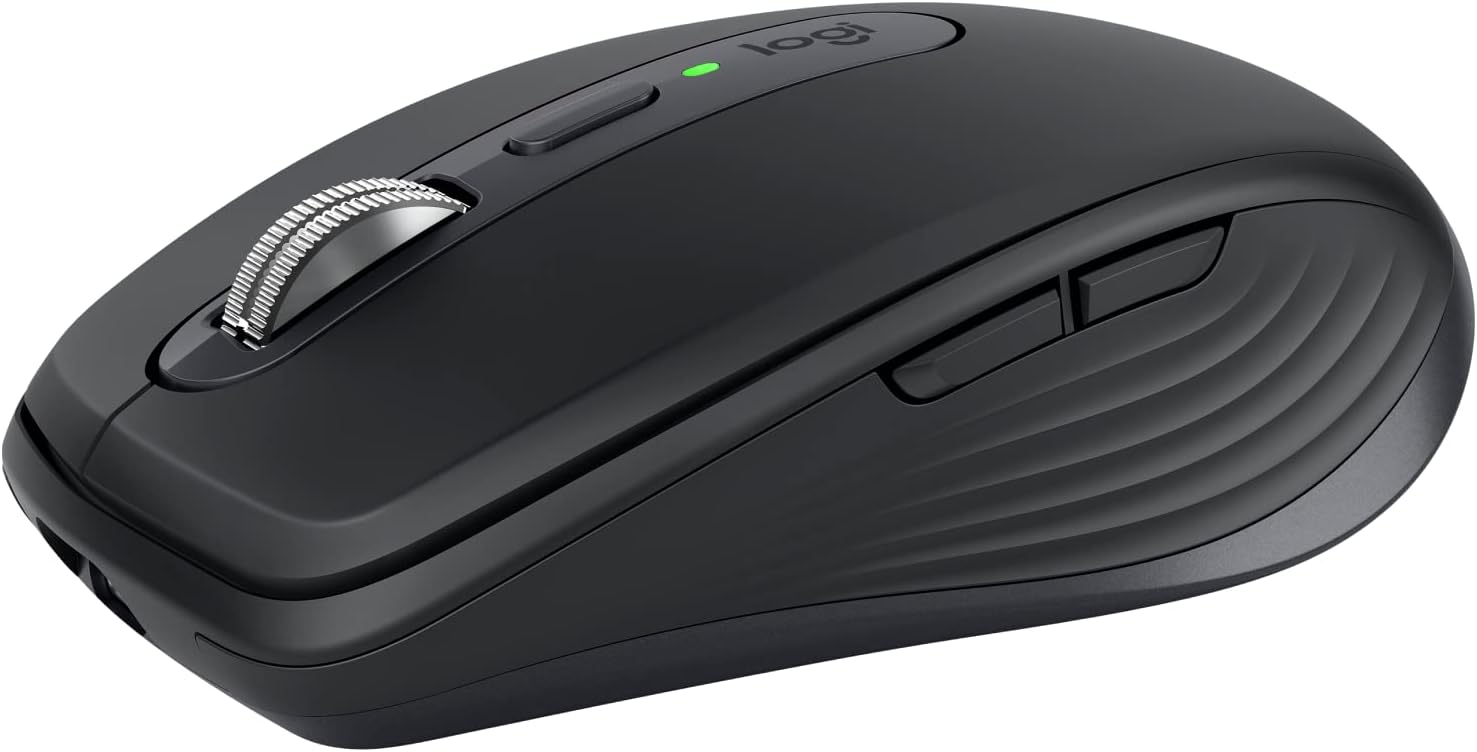
Need an ergonomic mouse that fits easily in your laptop bag without sacrificing quality? Enter the Logitech MX Anywhere 3, the ultimate portable ergonomic mouse for digital nomads, commuters, and remote workers.
Key Features:
Compact, sculpted design
Tracks on virtually any surface (even glass)
USB-C fast charging (70 days battery life)
Connects to up to 3 devices
Silent clicking for quiet environments
Its small size makes it ultra-portable, but it doesn’t skimp on ergonomics. The shape still supports your hand well, offering better comfort than typical “travel mice.” It’s also highly durable, making it a reliable companion on the go.
Potential Downsides:
Might not be ideal for users with very large hands
Lacks some of the additional thumb buttons found in larger models
Verdict:
For travelers seeking ergonomic relief without bulk, the Logitech MX Anywhere 3 is the best in its class.
Kensington Expert Mouse Wireless Trackball — Best for Minimal Movement
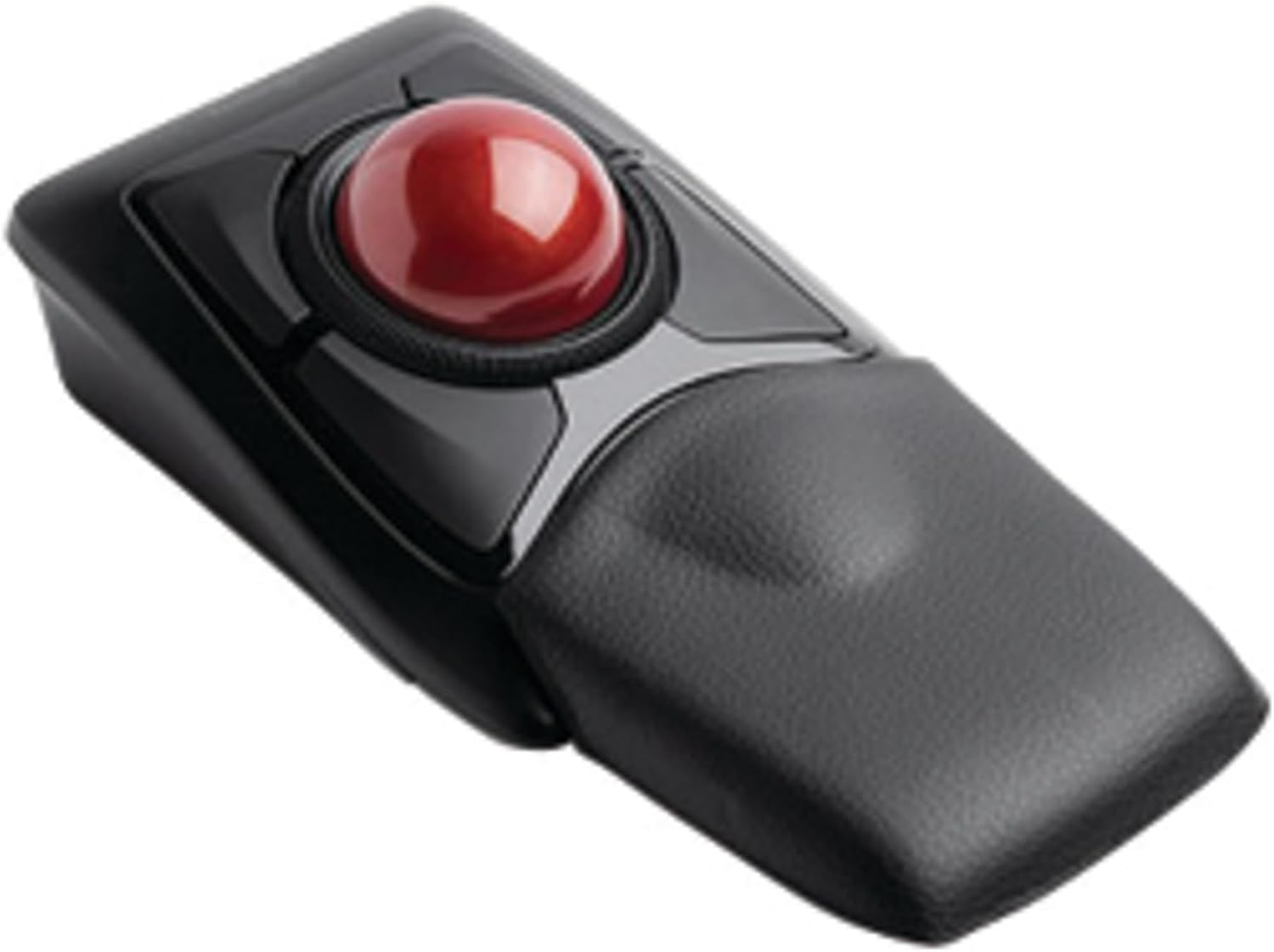
If you’re looking for an ergonomic solution that minimizes arm and wrist movement altogether, the Kensington Expert Mouse Wireless Trackball is a standout choice.
Key Features:
Large 55mm ball for precise cursor control
Scroll ring around the ball for easy page navigation
Four customizable buttons
Dual wireless connectivity (Bluetooth and USB dongle)
Ambidextrous design
Because your arm stays stationary while your fingers do all the work, trackball mice like this can significantly reduce repetitive strain. The large ball provides smooth, accurate control, and the ability to switch hands makes it even more ergonomic.
Potential Downsides:
Steeper learning curve compared to traditional mice
Bulky footprint; not ideal for very small desks
Verdict:
For users who want to minimize arm movement and maximize wrist health, the Kensington Expert Mouse Wireless Trackball is an outstanding ergonomic option.
Anker Ergonomic Vertical Mouse — Best Budget Ergonomic Choice
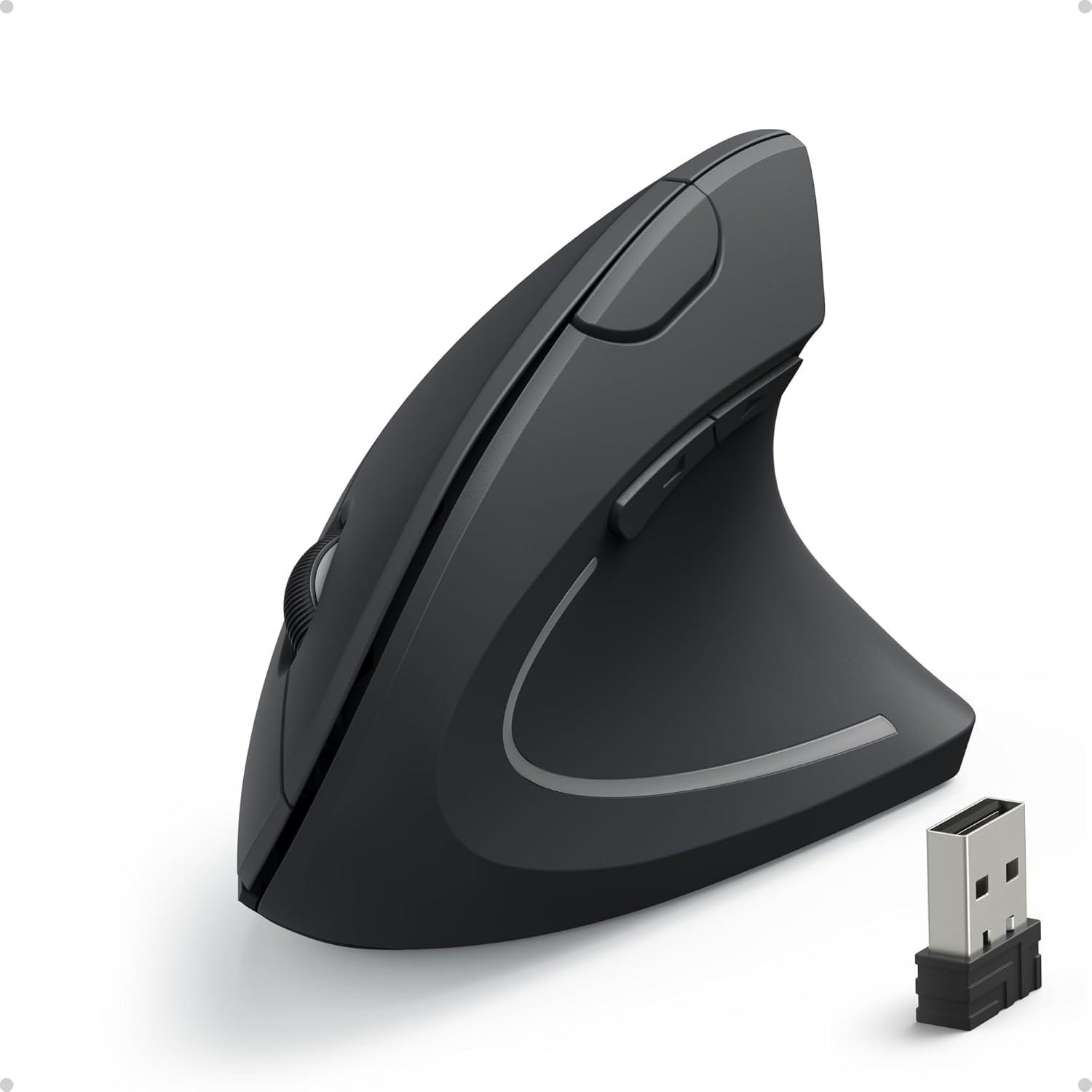
You don’t have to spend a fortune to reap the benefits of ergonomic design. The Anker Ergonomic Vertical Mouse offers an excellent entry-level option for users who want to upgrade their setup without breaking the bank.
Key Features:
Vertical handshake design
1,600 DPI optical sensor
Five buttons for improved functionality
Lightweight and simple setup (plug-and-play)
The Anker Vertical Mouse encourages a neutral wrist position at an affordable price. It’s especially good for people curious about vertical mice who want to test the benefits before committing to a more expensive model.
Potential Downsides:
Plastic feel and basic construction
Not as customizable or durable as premium models
Verdict:
If you’re new to ergonomic mice and want a budget-friendly vertical option to improve wrist health, the Anker Ergonomic Vertical Mouse is a fantastic starting point.
Tips for Correct Mouse Posture and Desk Setup
Even the best ergonomic mouse won’t deliver its full benefits if you’re using it in an unhealthy way. Correct posture and a thoughtfully organized desk setup are just as important as the mouse itself when it comes to preventing discomfort, boosting productivity, and promoting long-term health.
Correct Mouse Posture: Essential Techniques
1. Keep Your Wrist Neutral
Your wrist should be straight and aligned with your forearm, not bent upwards (extended) or downwards (flexed).
Avoid resting your wrist heavily on the desk or mouse pad, as this can compress blood vessels and nerves.
Think of your hand and forearm as a straight line extending from your elbow.
2. Use a Light Grip
Gripping the mouse too tightly increases tension in your fingers, hand, and forearm muscles.
Use just enough force to guide the mouse, allowing your hand to remain relaxed.
Think of “guiding” the mouse rather than “holding” it.
3. Move from the Elbow and Shoulder
Large movements should come from your elbow and shoulder, not from your wrist alone.
This distributes movement across larger muscle groups, reducing the strain on smaller, more vulnerable muscles and tendons in your wrist and fingers.
4. Keep Your Mouse Close
Position the mouse close to your body and at the same height as your keyboard.
Your upper arm should hang naturally by your side without reaching or extending forward.
Ideally, the mouse should be within easy reach without having to lean or twist your torso.
5. Maintain a Natural Hand Position
If your fingers or thumb feel strained, adjust the mouse size or shape.
A well-fitting mouse allows your fingers to curve gently, matching the natural relaxed hand posture.
Desk Setup: Ergonomics That Support Good Posture
1. Proper Desk and Chair Height
Adjust your chair so your elbows are bent at 90 to 100 degrees when your hands are on your mouse and keyboard.
Your thighs should be parallel to the floor, and your feet flat on the ground (or on a footrest if necessary).
2. Align Your Monitor at Eye Level
The top third of your monitor screen should be at or slightly below your eye level.
You should be able to view your screen comfortably without tilting your head up or down.
A poor monitor position can cause forward head posture, leading to neck and upper back pain.
3. Desk Organization
Place your keyboard and mouse on the same surface and at the same level to avoid uneven shoulder elevation.
Arrange frequently used items within arm’s reach to prevent repetitive stretching.
4. Support Your Arm and Elbow
If possible, use a chair with adjustable armrests that support your forearms without elevating your shoulders.
Alternatively, use a desk that allows you to rest part of your forearm to reduce shoulder strain.
5. Invest in a Quality Mouse Pad or Wrist Support
A mouse pad with a soft wrist support can help maintain neutral wrist posture.
However, make sure you are not pressing down heavily on the support—it should simply provide a resting option between mouse movements.
Small Habits That Make a Big Difference
1. Take Regular Breaks
Follow the 20-20-20 rule: Every 20 minutes, look at something 20 feet away for at least 20 seconds to reduce eye strain.
Stretch your hands, fingers, shoulders, and back every hour.
2. Switch Hands Occasionally
If you’re comfortable, occasionally switch your mouse to the non-dominant hand to distribute muscle use.
Even short sessions with the opposite hand can help prevent overuse injuries.
3. Perform Hand and Wrist Exercises
Gentle stretches like wrist flexor and extensor stretches, finger spreads, and fist clenching exercises can enhance flexibility and blood flow.
4. Pay Attention to Discomfort
Minor aches are your body’s early warning system. Adjust your posture, equipment, or habits at the first sign of discomfort rather than waiting for serious pain to set in.
The right ergonomic mouse is a powerful tool, but it’s only part of the equation. True comfort and productivity come when you combine good equipment with smart posture habits and a properly arranged workspace. By implementing these ergonomic strategies, you’ll not only work more efficiently—you’ll also protect your body for the long haul.
FAQ: Ergonomic Mouse Buying and Usage
An ergonomic mouse is designed to fit the natural shape and movement of your hand, wrist, and forearm. It minimizes strain, reduces awkward angles, and promotes a neutral posture, helping to prevent repetitive strain injuries like carpal tunnel syndrome or tendonitis.
If you experience wrist pain, finger fatigue, arm soreness, or notice numbness or tingling in your fingers after using your mouse, it may be time to switch to an ergonomic model. Even if you’re not in pain now, upgrading to an ergonomic mouse can prevent future problems—especially if you spend multiple hours a day at a computer.
For many users, yes. A vertical mouse positions your hand in a handshake posture, reducing forearm rotation and wrist bending. This can significantly lower the risk of wrist pain and is especially beneficial for people already dealing with carpal tunnel syndrome, arthritis, or repetitive stress injuries.
Trackball mice can be very ergonomic because they eliminate the need to move your entire arm or wrist. Instead, you control the cursor by rotating a ball with your fingers or thumb. This stationary design reduces shoulder and arm strain and can be ideal for users with limited mobility or small workspaces.
From a pure ergonomic standpoint, wireless mice are often better because they offer greater freedom of movement without the drag or restriction of a cable. However, as long as a wired mouse has proper cable management and good design, it can still provide excellent ergonomic support.
Size matters! A mouse that’s too big can cause overreaching and muscle tension, while a mouse that’s too small may force your hand into a cramped position. Ideally, your hand should rest naturally over the mouse without your fingers or palm hanging off. Many manufacturers list sizing recommendations based on hand measurements, so it’s important to check before you buy.
Switching can provide noticeable relief, but results vary. Some users feel improvement within a few days, while others might need a few weeks to fully adjust. In addition to switching your mouse, it’s crucial to correct your desk posture, take regular breaks, and possibly perform wrist and hand stretches for best results.
Conclusion: Comfort That Boosts Your Workflow
Choosing the right ergonomic mouse is more than just a matter of convenience—it’s a proactive step toward protecting your health, enhancing your productivity, and making your daily computer use more enjoyable. Whether you’re working long office hours, gaming competitively, or traveling frequently, using a mouse that supports the natural posture of your hand, wrist, and forearm can make a profound difference.
Throughout this guide, we’ve explored the key types of ergonomic mice, from vertical and trackball designs to split and contoured models. We’ve discussed the pros and cons of wired vs. wireless options, reviewed some of the best ergonomic mice available today, and shared actionable tips for setting up your desk and improving your posture. The goal isn’t just to find a better mouse—it’s to create a healthier, more efficient workspace that works with your body, not against it.
Here’s a quick reminder of what to prioritize:
Choose a mouse that fits your hand size and grip style.
Consider the type of ergonomic shape that best suits your needs (vertical, trackball, split).
Think about your work environment—wired might suit a fixed office setup, while wireless offers flexibility for travel or dynamic desks.
Don’t neglect your desk setup; monitor height, chair adjustment, and keyboard placement all play critical roles in comfort.
Stay mindful of your posture, grip pressure, and movement habits throughout the day.
Making the switch to an ergonomic mouse, combined with healthy workspace habits, can help prevent chronic pain, improve your workflow, and even boost your energy levels by reducing physical stress.
